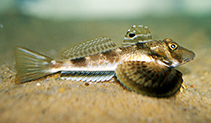| Family: |
Triglidae (Searobins), subfamily: Prionotinae |
| Max. size: |
38 cm TL (male/unsexed) |
| Environment: |
demersal; brackish; marine; depth range 15 - 170 m |
| Distribution: |
Western Atlantic: Nova Scotia in Canada to central Florida in USA. Gulf of Mexico (Ref. 26938). |
| Diagnosis: |
|
| Biology: |
Occurs on sandy bottom. Feeds on shrimps, crabs, other crustaceans, squid, bivalves and small fishes. Produces loud, drumming sound by vibrating its swim bladder (Ref. 9988). Used both for food and fish meal; other uses include bait for lobster traps and flatfish, handlines, pet food and fertilizer. Utilized fresh and frozen; also used for caviar ; can be broiled and baked (Ref. 9988). |
| IUCN Red List Status: |
Least Concern (LC); Date assessed: 22 August 2012 Ref. (130435)
|
| Threat to humans: |
harmless |
Source and more info: www.fishbase.org. For personal, classroom, and other internal use only. Not for publication.
